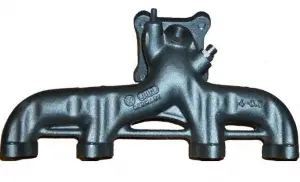
Gray cast iron is the oldest and most common type of iron in existence and probably what most people think of when they hear the term “cast iron”. The carbon and silicon contents of gray cast irons vary between 2.5 and 4.0 wt% and 1.0 and 3.0 wt%, respectively.
Gray cast iron have also an excellent damping capacity, which is given by the graphite because it absorbs the energy and converts it into heat. A large damping capacity is desirable for materials used in structures where unwanted vibrations are induced during operation such as machine tool bases or crankshafts. Materials like brass and steel have small damping capacities allowing vibration energy to be transmitted through them without attenuation.
Thermal Properties of Gray Cast Iron – ASTM A48 Class 40
Thermal properties of materials refer to the response of materials to changes in their thermodynamics/thermodynamic-properties/what-is-temperature-physics/”>temperature and to the application of heat. As a solid absorbs thermodynamics/what-is-energy-physics/”>energy in the form of heat, its temperature rises and its dimensions increase. But different materials react to the application of heat differently.
Heat capacity, thermal expansion, and thermal conductivity are properties that are often critical in the practical use of solids.
Melting Point of Gray Cast Iron – ASTM A48 Class 40
Melting point of gray cast iron – ASTM A48 steel is around 1260°C.
In general, melting is a phase change of a substance from the solid to the liquid phase. The melting point of a substance is the temperature at which this phase change occurs. The melting point also defines a condition in which the solid and liquid can exist in equilibrium.
Thermal Conductivity of Gray Cast Iron – ASTM A48 Class 40
The thermal conductivity of gray cast iron – ASTM A48 is 53 W/(m.K).
The heat transfer characteristics of a solid material are measured by a property called the thermal conductivity, k (or λ), measured in W/m.K. It is a measure of a substance’s ability to transfer heat through a material by conduction. Note that Fourier’s law applies for all matter, regardless of its state (solid, liquid, or gas), therefore, it is also defined for liquids and gases.
The thermal conductivity of most liquids and solids varies with temperature. For vapors, it also depends upon pressure. In general:
Most materials are very nearly homogeneous, therefore we can usually write k = k (T). Similar definitions are associated with thermal conductivities in the y- and z-directions (ky, kz), but for an isotropic material the thermal conductivity is independent of the direction of transfer, kx = ky = kz = k.
We hope, this article, Thermal Properties of Gray Cast Iron, helps you. If so, give us a like in the sidebar. Main purpose of this website is to help the public to learn some interesting and important information about materials and their properties.
